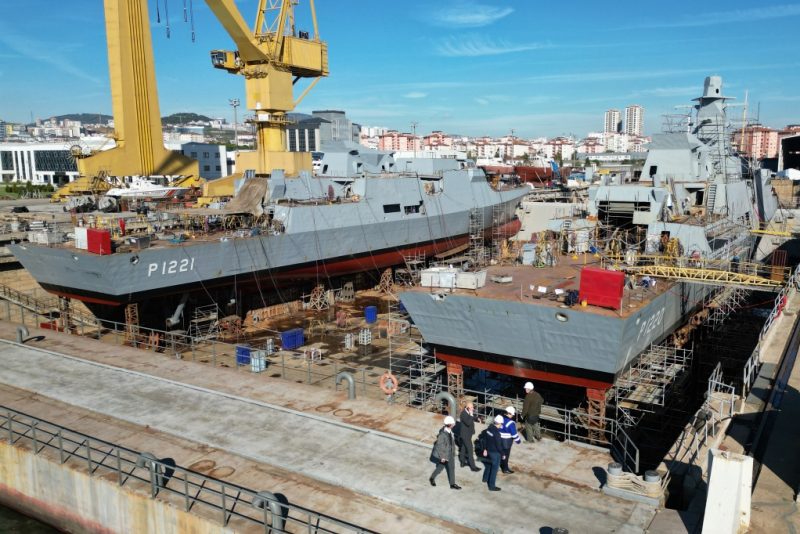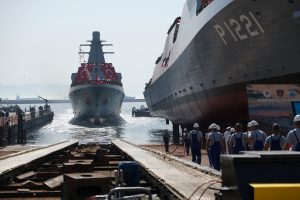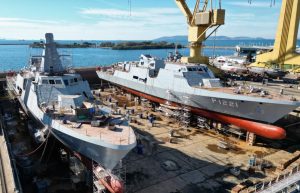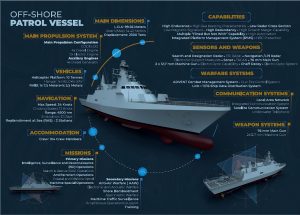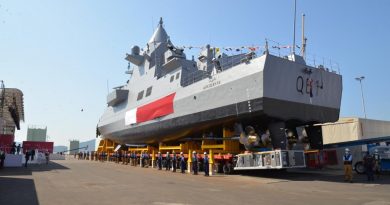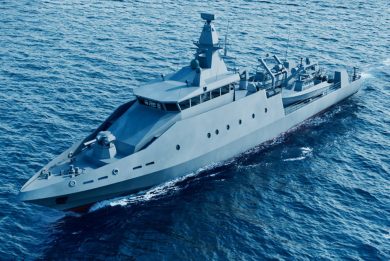ASFAT’s latest naval solution: the Hisar class OPVs
The latest addition to ASFAT naval products portfolio is the Hisar class OPV design developed for the Turkish Naval Forces Command, having in mind a modular and “fitted for but not with” solution with growth capabilities for the domestic and international market. In November 2020 ASFAT was awarded a contract by the Turkish MoD for the design, construction and delivery of two OPVs out of a requirement for a class of planned 10 units
In about nine months, the wholly Turkish Government-owned entity created under the Ministry of National Defence to support military factories and shipyards and the national defence industry development on foreign and national markets, completed the ship design and the critical design phase, and celebrated the first steel cut ceremony of first-of-class Akhisar (P 1220) OPV in August 2021, followed by its twin Koçhisar (P 1221) in December 2022 at Istanbul Naval Shipyard. The two platforms were launched on the same day on 23 September 2023 with a ceremony attended by the Turkish Defence Minister Yasar Güler and his Pakistani counterpart Anwar Ali Hayder, concurrently with the delivery to Pakistan of the first of four corvettes built under the export programme managed by ASFAT with ship construction in Turkey and Pakistan.
EDR On-Line was part of the international media tour visit at Istanbul shipyard, where the two OPVs could be seen in the dry dock completing the superstructures assembly to advance in final fitting out activities, harbour and sea trials for a planned delivery of the first-of-class in August 2024. The second OPV is understood to be following at a four-month interval but no indication has been provided on ship delivery. EDR On-Line understood it could be delivered in late 2024 or early 2025. Regarding follow-on class ships, although no indication has been provided, new procurements plan should be issued by the Turkish Government by the end of 2023. The Turkish Naval Forces Command needs to replace the ageing Burak-class corvettes, ex D’Estienne d’Orves-class A69 type aviso.
With a 2,300 tonnes displacement, a length and beam of respectively 99.56 and 14.42 meters, the new OPV shares the same hull design and overall superstructures layout of the Ada-class corvette but features different superstructures arrangement with new masts configuration for the embarked sensors as well as a different structural layout, internal compartmentalization and propulsion system, allowing it to be built in a shorter timeframe and at lower cost. “The new OPVs maintain the same proven and high sea-keeping hull characteristics alongside low radar cross section and magnetic signature of the Ada class corvettes, ensuring platform commonalities and high growth margin capabilities,” Sinan Topuz, director of business development at ASFAT, said. The new ships are designed to accomplish a range of primary missions, namely intelligence, surveillance and reconnaissance (ISR), coast and offshore water patrol, maritime special and anti-terrorism operations, alongside Search and Rescue (SAR), but can be called to carry out secondary missions such as anti-air warfare (AAW), electronic and anti-submarine warfare, shore bombardment, asymmetric warfare, maritime traffic surveillance and amphibious warfare.
The new Hisar class OPVs features a propulsion system based on a CODELOD (Combined Diesel ELectric or Diesel) configuration with four MAN 20V175D diesel engines providing 3,700 kW each and two electric motors of local production providing 1,000 kW each. The two diesel engines, located in separate compartments, are connected to a gearbox alongside one 1,000 kW electric motor positioned on each shaft to ensure maximum survivability through horizontal separation between the two shaft lines. It provides maximum and cruise speed of respectively 24 and 20 knots with a range of 4,500 nm at economical speed and a 21-day endurance. The electric motors are used for patrolling operations at low speed while diesel engines provide medium and high speeds. Electrical power is ensured by four diesel generators. The Hisar class OPVs are equipped with the same PiKET3000 family’s integrated platform and management system (IPMS) provided by Yaltes as of the Turkish Navy in-service or entering into service platforms , alongside the firefighting damage control, onboard training systems, closed-circuit TV and stability system. With accommodations for 104 among crew members, flight detachment and special forces, the OPV has the same flight deck and hangar of the Ada-class corvettes, capable to operate a 10 tonnes helicopter such as the SH-60Bs, with space reservation to embark an unmanned air vehicle and its control systems. The new OPVs feature a stern launch and recovery station for a 5,5 meters RHIB while a davit system is used to operate a 7,5 meters RHIB by a ship port side bay.
As anticipated, “the new Hisar class OPV design has been conceived to be modular with growth capabilities, allowing the platform to evolve with the addition of new systems and weapons,” explained the director of business development at ASFAT Exploiting “the fitted but not with” capacity, the Turkish Navy and other potential customers can put into service a baseline configuration that can be later enriched based on available budget and mission needs.
The new OPV’s mission and weapons suite for the Turkish Navy is based on the same Havelsan Advent combat management system (CMS) with data distribution and local area network, integrated communication system including Link 11/16 and X- and Ku-band SATCOM, already in service with other recent shipbuilding programmes such as the I-class frigates. The Advent CMS manages a sensors package based on an Aselsan MAR-D 3D phase array main surveillance and designation radar alongside a new generation Tubitak Yelkovan radar electronic support measures suite. The latter is a first application for the Turkish Navy and according to information released by Tubitak, is characterized by an integrated digital broadband and narrowband receiver architecture and lightweight configuration, with advanced and powerful automated surveillance, identification and precise direction finding technology allowing high performances in contested and congested environments. The main surveillance sensor suite also includes an Aselsan Piri IRST (Infra-Red Search and Tracking). In addition to a navigation suite with dedicated conventional and low probability of intercept radars from Aselsan, the sensor package also includes two Aselsan Akrep (AKR-D Block1/Block2) radar and one Aselsan Ahtapot-S electro-optical fire control directors for the main and secondary armament, while self-protection is provided by MKE decoy launchers. The underwater protection suite is based on the Meteksan Yakamos 2020 hull-mounted sonar. The armament package includes for the first time a MKE 76/62 mm main gun and two Unirobotics Targan remote controlled weapon systems (RCWS) armed with Canik Arms 12.7 mm machine guns developed together with ASFAT, making the Turkish Navy the launch customer for both new weapon systems. As anticipated, the Hisar-class OPVs for the Turkish Navy are “fitted for but not with” a reinforced electronics and weapon package including an Aselsan Gökdeniz twin 35 mm gun defence system with integrated radar/EO-IR FCS positioned over the hangar, and a multirole missiles suite amidship. The latter area can accommodates up to two 4-launcher for the Roketsan ATMACA anti-ship or Cakir strike missiles alongside two 4-cell lightweight version of the new MIDLAS or national vertical launching system for HISAR surface-to-air missiles family by Roketsan. ASFAT is also evaluating a reduced-size and less-capable version of the Aselsan Cenk multifunction 3D AESA radar to provide a wide air surveillance and tracking capability. This solution could equip a 5-meter longer hull version of the Hisar-class OPV should the growth potential of the design attract the interest of potential customers.
Photos courtesy ASFAT

